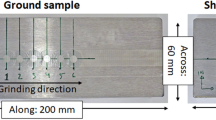Abstract
Due to stable performance and great hardness of nickel-based superalloy, single magnetic abrasive finishing (MAF) is difficult to polish the nickel-based superalloy workpiece, which makes the grinding efficiency decrease. The effective combination of electrolytic polishing process (EPP) and magnetic abrasive finishing process can improve processing efficiency by reducing the influence of material hardness. In order to verify the feasibility of this method, large numbers of experiments on the electrolytic-magnetic abrasive finishing (EMAF) of nickel-based superalloy GH4169 were carried out. Experimental results show that the EMAF can change the surface component content of workpiece to reduce the material hardness and make the surface roughness value reduce significantly and the surface morphology smoother; the processing efficiency is improved by 50 %.
Similar content being viewed by others
References
Huang XC, Zhang DH, Yao CF, Ren JX (2013) Effects of grinding parameters on surface integrity of GH4169 nickel-based superalloy. Journal of Aerospace Power 28(3):621–628
Lu XD, Du JH, Deng Q (2013) High temperature structure stability of GH4169 superalloy. Materials Science & Engineering A 559(1):623–628
Li HY, Kong YH, Chen GS, Xie LX, Zhu SG, Sheng X (2013) Effect of different processing technologies and heat treatments on the microstructure and creep behavior of GH4169 superalloy. Materials Science & Engineering A 582(11):368–373
Kang J, Yamaguchi H (2012) Internal finishing of capillary tubes by magnetic abrasive finishing using a multiple pole-tip system. Precis Eng 36(3):510–516
Han B, Deng C, Chen Y (2013) Application of spherical magnet in magnetic abrasive finishing of elbow inner-surface. Tribology 33(6):565–570
Mulik RS, Pandey PM (2011) Magnetic abrasive finishing of hardened AISI 52100 steel. Int J Adv Manuf Technol 55(5-8):501–515
Lin CT, Yang LD, Chow HM (2007) Study of magnetic abrasive finishing in free-form surface operations using the Taguchi method. Int J Adv Manuf Technol 34(1-2):122–130
Lee YH, Wu KL, Bai CT, Liao CY, Yan BH (2014) Planetary motion combined with two-dimensional vibration-assisted magnetic abrasive finishing. Int J Adv Manuf Technol 76(9-12):1865–1877
Kim JD (2003) Polishing of ultra-clean inner surfaces using magnetic force. Int J Adv Manuf Technol 21(2):91–97
Givi M, Tehrani AF, Mohammadi A (2012) Polishing of the aluminum sheets with magnetic abrasive finishing method. Int J Adv Manuf Technol 61(9-12):989–998
Yang LD, Lin CT, Chow HM (2009) Optimization in MAF operations using Taguchi parameter design for AISI304 stainless steel. Int J Adv Manuf Technol 42(5-6):595–605
Jayswal SC, Jain VK, Dixit PM (2005) Modeling and simulation of magnetic abrasive finishing process. Int J Adv Manuf Technol 26:477–490
Singh DK, Jian VK, Raghuram V (2006) Experimental investigations into forces acting during a magnetic abrasive finishing process. Int J Adv Manuf Technol 30:652–662
Chen Y, Liu ZQ, Wang XK (2013) Ultrasonic vibration-assisted magnetic abrasive finishing. Agricultural Machinery 44(10):294–298
Liu ZQ, Chen Y, Li YJ, Zhang X (2013) Comprehensive performance evaluation of the magnetic abrasive particles. Int J Adv Manuf Technol 68(1-4):631–640
Zhang GX, Zhao YG, Zhao DB, Zhang PP (2012) Morphology and abrasive performance of magnetic abrasive prepared by sintering and atomizing methods. Materials for Mechanical Engineering 36(3):53–55
Yamaguchi H, Hanada K (2008) Development of spherical magnetic abrasive made by plasma spray. J Manuf Sci Eng 130(3):876–877
Lin TR, Su CR (2008) Experimental study of lapping and electropolishing of tungsten carbides. Int J Adv Manuf Technol 36(7–8):715–723
Lee ES (2000) Machining characteristics of the electropolishing of stainless steel (STS316L). Int J Adv Manuf Technol 16(8):591–599
Yan BH, Chang GW, Cheng TJ, Hsu RT (2003) Electrolytic magnetic abrasive finishing. Int J Mach Tool Manu 43(13):1355–1366
Liu GY, Guo ZN, Jiang SZ, Qu NS, Li YB (2014) A study of processing Al 6061 with electrochemical magnetic abrasive finishing. Procedia CIRP 14:234–238
Author information
Authors and Affiliations
Corresponding author
Rights and permissions
About this article
Cite this article
Du, Z.W., Chen, Y., Zhou, K. et al. Research on the electrolytic-magnetic abrasive finishing of nickel-based superalloy GH4169. Int J Adv Manuf Technol 81, 897–903 (2015). https://doi.org/10.1007/s00170-015-7270-4
Received:
Accepted:
Published:
Issue Date:
DOI: https://doi.org/10.1007/s00170-015-7270-4




